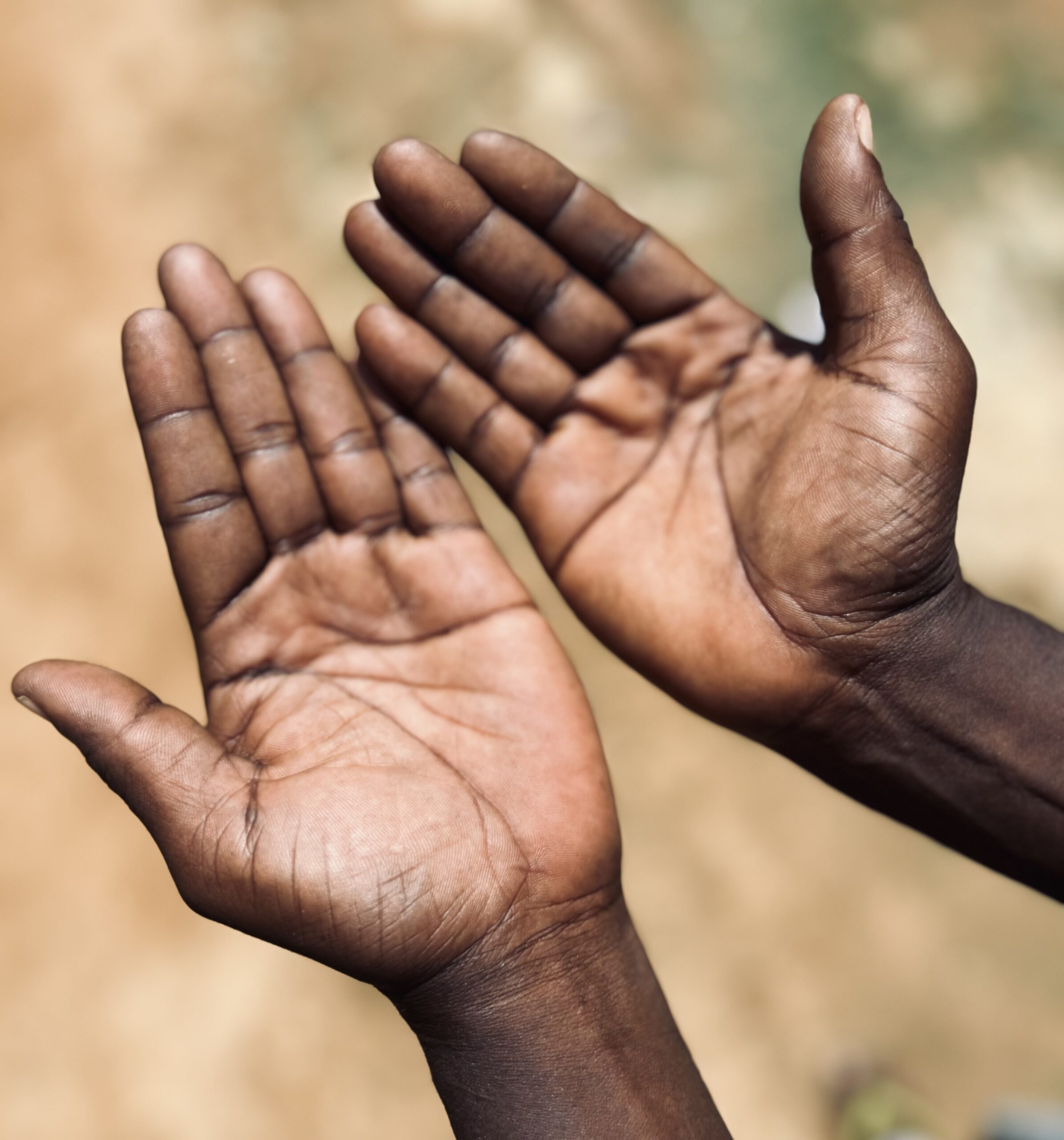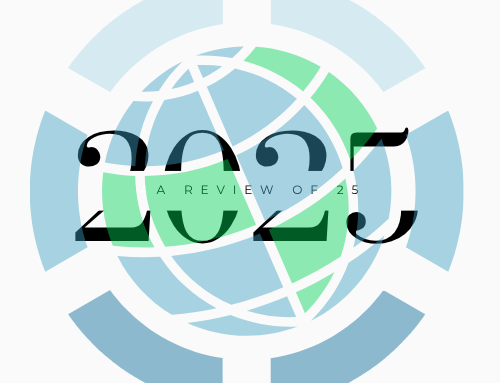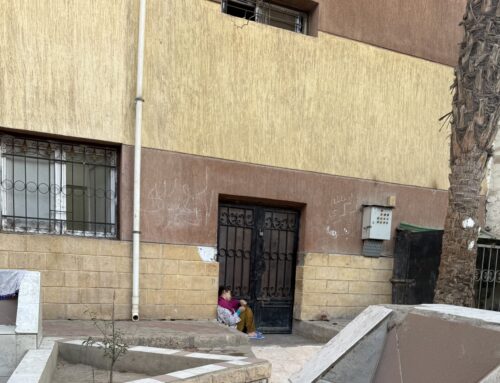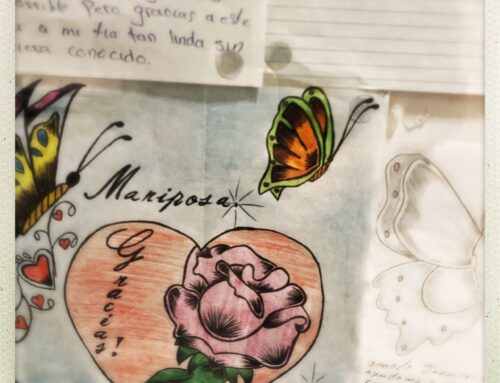
More than death, some migrants fear returning empty-handed from the EU African borderlands. This Liberian migrant in Niger shows his empty hands after losing his money and almost his life in the Sahara Desert. Niamey, 2024. Photo by Hans Lucht.
Omar stands tall in a shallow rock grave. We are on the cliffside at Tombeaux Phéniciens, the ancient Phoenician tombs in Tangier. He looks longingly across the Mediterranean Sea. Below us, along the winding road, security forces patrol. The seaside has been fortified with additional rocks and fences and surveillance technology to keep irregular migrants and children like Omar in. The Spanish coast is clearly visible in the clear evening sky. It appears almost as if you can swim across.
Omar sighs and picks his nose. Omar is 11 years old, or so he believes. Like most other children living in the streets in Morocco, he is socially and economically marginalised in his own country due to factors beyond his control—crippling poverty above all—and has only ever travelled from the rural outskirts to urban centres like Tangier.
Omar is not alone in this predicament. Thousands of children around the world are viewed as surplus populations, not only in an economic sense, but in a social and political sense too. They hail from different countries, but many of them congregate in states like Morocco. They live on the fringes, in the shadows, they scrape by any way they can, vulnerable to exploitation and abuse. Yet they exist and persevere and find ways of navigating their hostile terrains; they survive somehow, they stake their claims. The “existential imperative” to make more out of life than what we have been given also goes for the smallest and least powerful among us (Jackson 2005, 181).
Taking our departure in this fieldwork image of both vulnerability and perseverance, we make a few observations about the current human and political dilemmas of the multiple unfolding humanitarian crises surrounding global migration, such as the European migration crisis of 2015 and the Belarus–European border crisis, and how these crises have shifted perceptions of brutality against migrants in Europe. What is the moral economy behind this ongoing suffering? How do current social panics and militarization processes engender a fear of children like Omar?
A “hybrid war”
One reason for the widespread and normalized brutality in migration management in the Mediterranean and on the Eastern border is the increasing use of migrants by countries looking to pressure Europe into economic or political concessions that would otherwise be difficult or impossible to achieve. This has resulted in a siege mentality and a sense of victimhood in Europe among large parts of the European populations and among the ruling class. Migrants are increasingly used as pawns in what some European leaders have termed a “hybrid war,” where nations outside Europe sponsor irregular migration into Europe, which, in turn, must be countered with brutal measures to safeguard Europe.
Using migrants for political purposes is not a new strategy (Greenhill 2022). However, as recent history in the Mediterranean region shows, this strategy is strongly connected to Libya’s Colonel Gaddafi and his stormy dealings with Italy. Migration appears as the key weapon in this hybrid warfare that is now being framed as an existential threat to Europe. While this hybrid war is between nations, it is children like Omar whose lives are at stake, drowning in the sea or suffering abuse in North African prisons.
The hardening and warlike rhetoric against migration plays a role in this development too. Of course, migration has been viewed through a security lens for decades but was explicitly weaponised when Alexander Lukashenko, the authoritarian leader of Belarus, in 2020 directed migrants and asylum-seekers towards the borders of Latvia, Lithuania, and Poland. The ensuing brutality and death in the borderlands between Poland and Belarus were considered regrettable but necessary to protect the borders, vitality, and integrity of Europe.
Border violence can be seen as a type of “humanitarian violence,” a “lesser evil” deployed to make unnecessary even more brutal measures and even greater evils (Weizman 2012, 8–9). In other words, administering instant brutality by proxy, such as when the European Union increasingly sponsors the securitization of migration in nations such as Morocco or Tunesia, or when natural environments are weaponized, are measures intended to make children like Omar hesitate before trying to flee, in the long run supposedly diminishing the overall need for violence. Yet this approach does not attend to migrant lives as they unfold in the margins, nor why people move to begin with.
Political perils and social panic
What underlies the perceived existential threat of migrants? The notion that migrants and minorities are a political peril and are used as tools by enemy states, political rivals, or sinister global forces has a long and troubled history in both Europe and the US, sometimes combined with antisemitic and Islamophobic tropes. This theme has resurfaced in recent years as justification for even more brutality framed as security. In Europe as well as in the US, the fear of “replacement” by invading migrants combined with a sense of victimhood has gathered support in recent years and moved from the political fringes to the center. In North Africa, in an infamous speech, the Tunisian president Saied expressed fear of sub-Saharan Africans substituting for the Tunisian majority. This speech precipitated instant violence and deportations.
With an aging European population and low fertility rates, migrants are needed in many European industries, including farming, manufacturing, and health care. Again, we see a contradiction: greater demand and need for migrants combined with deteriorating levels of social and political acceptance of migration. Yet there is a capitalist logic to the irregular labor markets in especially Southern Europe that exist alongside regular employment for citizens. Some actors in these labor markets, including agricultural companies that recruit irregular migrants on a seasonal basis, support struggling industries. Worsening migrant precarity hampers claims to rights and fair economic compensation (see also Lucht 2024).
Finally, despite knowing little about the predicament of migrant children like Omar, relentless media coverage of migrant deaths, violence, and abandonment has prompted little understanding, accountability or political change in Europe. On the contrary, it seems, the proliferation of texts and images of migrant suffering seem to neutralize outrage and obscure the brutal realities that migrants face (Baudrillard 1994, 79; Lucht 2024).
Omar’s slight childish frame is no match for the security measures designed to immobilize him. The dominance and brutality of the border apparatus are perverse in comparison. Yet, the innocence and promise of childhood simultaneously challenges and renders visible the dilemmas and disasters of migration management. The increasing prevalence of migration as a tool in hybrid warfare increases the political demand for more strict and weaponized border regimes.
Omar’s hopes and dreams, his mere existence in a world that offers him so little, challenge us to move beyond depictions of migrant children as either pawns or passive victims of violence and abandonment. We must instead look for the ways they assert their agency, reclaim their dignity, and navigate the harsh realities of Europe’s militarized borders.
References
Baudrillard, Jean. 1994. Simulacra and Simulation. University of Michigan Press.
Greenhill, Kelly M. 2022. “When Migrants Become Weapons: The Long History and Worrying Future of a Coercive Tactic.” Foreign Affairs 101 (2): 155–64.
Jackson, Michael. 2005. Existential Anthropology: Events, Exigencies and Effects. Berghahn.
Lucht, Hans. 2024. “Distressed: Migrant Underworlds and Travels in Hyporeality.” Anthropological Theory 25(3): 268-288. .
Weizman, Eyal. 2012. The Least of All Possible Evils: A Short History of Humanitarian Violence. Verso.
Amin Younes Aoussar is a social and political anthropologist and with a special interest in migration and North African and West Asian studies. He finished his BA and MA in anthropology at the University of Copenhagen and worked on trafficking in persons issues at the United Nations Office on Drugs and Crime and as a research assistant at the Centre for Global Criminology at the University of Copenhagen, before starting his PhD project at the Centre for Advanced Migration Studies at the University of Copenhagen.
Hans Lucht is an anthropologist and Senior Researcher at the Danish Institute for International Studies (DIIS). Lucht has studied irregular migration and migration facilitation across the Sahara and the Mediterranean for about twenty years, with fieldwork primarily in Ghana, Niger, Libya, and Italy. Lucht’s most recent book, Vores liv ryster/Our Lives Are Shaking (2024), is a collection of documentary poetry using only migration voices arranged in verse to narrate the journey from a small West African fishing village to Europe and back home again.
Cite as: Aoussar, Amin Younes and Hans Lucht. 2025. “Omar and Europe’s Militarized Borders”. In “Bordering and the War on Migration”, edited by Anna Simone Reumert, Wendy Vogt, and Charlie Piot, American Ethnologist website, 23 September 2025. [https://americanethnologist.org/online-content/omar-and-europes-militarized-borders-by-amin-younes-aoussar-and-hans-lucht/]
This piece was edited by American Ethnological Society Digital Content Editor Kathryn E. Goldfarb (kathryn.goldfarb@colorado.edu).




